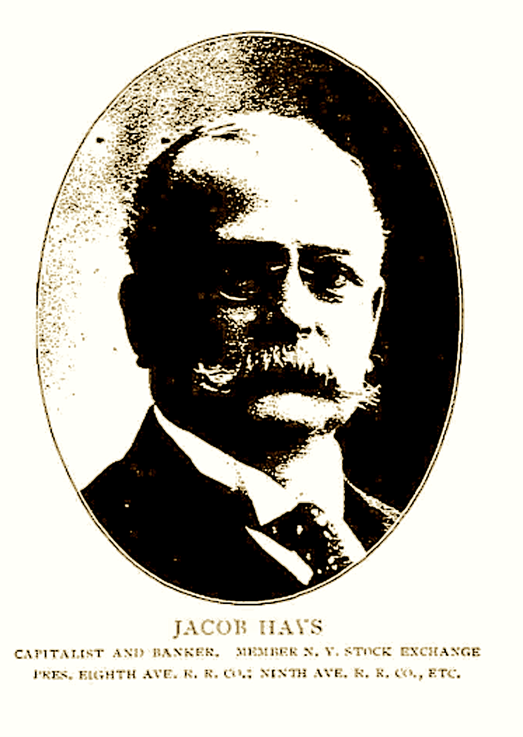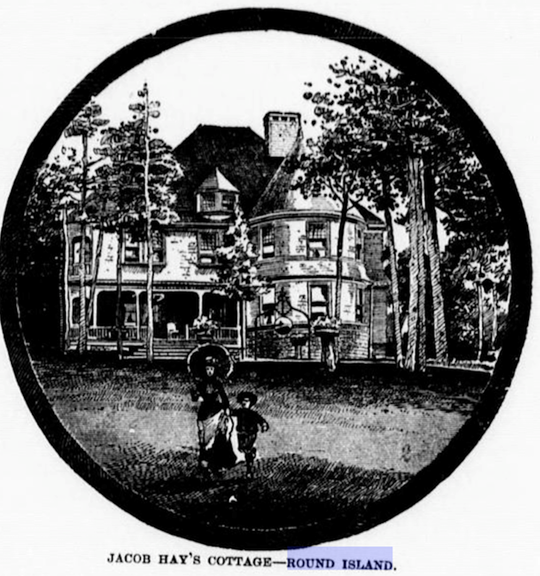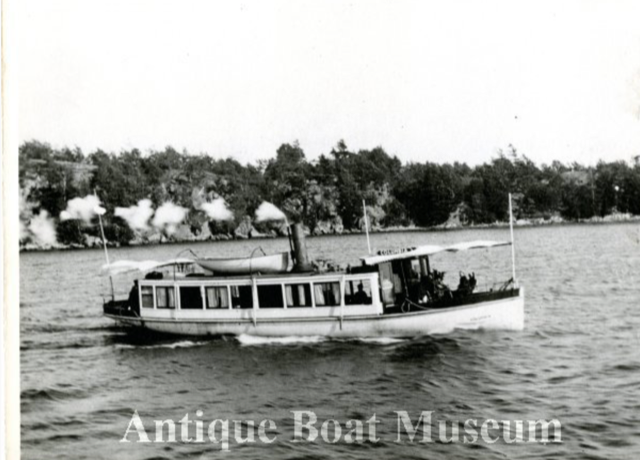Jacob Hays of Round Island was born into an esteemed New York City family. Unlike many of the self-made millionaires who came to the Thousand Islands with new fortunes and connections, Hays entered the River scene with the advantages of financial experience, AND the privilege that comes from a long family history of connections with NYC’s most powerful men.

The grandfather of Jacob Hays (also named Jacob Hays) was well known in New York. For over fifty years, he had held the position of High Constable of the City of New York (now known as the Superintendent of Police).
Jacob Hays’ father, William Henry Hays, was esteemed in New York City financial circles. He was a member of the old Board of Brokers, which became the New York Stock Exchange, and he occupied a seat in the very first New York Stock Exchange. William Hays also held prominent positions in the banking industry, as well as being actively involved in the management of New York railroad lines and steamship ferry lines.
Our Jacob Hays (1845 -1903) followed in his father’s footsteps and he was highly regarded in financial circles. In 1866. In the same year, joined the New York Stock Exchange and he established an investment firm, which represented the interests of many of New York City’s elite, such as Commodore Vanderbilt, a railroad and steamship tycoon; Samuel J. Tilden, Governor of New York State; George Law, investor in railroads and steamship lines; and Hugh McCullough, United States Treasury Secretary. Jacob Hays served as the President of the Eighth and Ninth Avenue Railroads, and as a director of the Tenth and Twenty-Third Street Ferry Company. He was a director of the Knickerbocker Trust Company and the Knickerbocker Safe Deposit Company.
In 1866, Jacob Hays married Mary Jane Louderback of New York. Upon his marriage to Mary Jane, Jacob converted to the Baptist Church. Hays was influential in the affairs of the First Baptist Church of New York, serving as a trustee of that congregation. It was not unexpected that Hays would have an interest in the newly developing community on Round Island, which had early connections with the Baptist Church.
Jacob and Mary Jane had two children: Elizabeth and William. In April 1888, daughter Elizabeth (Lizzie) married John Scott Browning of the renowned Browning Clothier family. John Scott Browning inherited a one-third share of his family’s business, which had been founded by his grandfather, John H. Browning. It was said that this business sold over a million dollars worth of military uniforms to the United States Army in 1861. The company passed through three generations of the Browning family enjoying a reputation as a premier clothier in the United States. The New York City wedding was a gala affair with over 1000 guests. The bride was adorned in diamond jewelry, gifts of her parents and in-laws. Notable guests included Mr. and Mrs. James Belden, (Round Island residents), Mr. and Mrs. William Rockefeller, and Mr. and Mrs. William C. Browning.
In 1898, son Will married a Vassar College graduate, Miss Mary Sanders, daughter of Dr. and Mrs. Sanders. An article in the society pages of the New York Herald, October 23,1898, recounts an elaborate wedding celebration, with gifts from such New York dignitaries as Mr. and Mrs. John D. Rockefeller, Mr. and Mrs. Daniel Lamont (Grover Cleveland’s Secretary of War), and several family members of Jay Gould.[1]
It is clear from this brief biography that Jacob Hays came to Round Island with a knowledge of finance and real estate, and with the friends, family, and business connections that would contribute to the development of Round Island Park and to the greater Saint Lawrence River community.

There are reports that the Hays home on Round Island was built in 1888. However, newspapers of the era record that the house was built in 1886, and that the Hays family arrived to stay there that summer.
The Watertown Re-union, March 17, 1886, gives an account of a new cottage being built on the head of Round Island for Jacob Hays: “Mr. H. S. Barbour, with 25 workmen, has begun work for four weeks on Round Island.”
A few weeks later on April 21, 1886, we read, “Henry S. Barbour, of this city, is erecting at the head of Round Island, one of the most elegant cottages on the river. The cottage is being built for Jacob Hayes [sic], of New York City, and will cost about $20,000. It is a three-story structure, and is from top to bottom a model of perfection. Mr. Barbour is a first-class builder and the masterly style in which the building is being erected fully sustains his reputation as such.” [2]
Henry S. Barbour’s reputation in Jefferson County was confirmed in his obituary from the Watertown Times, June 7, 1922, which adds that Barbour, a Baptist, built about 20 cottages on Round Island.
On June 02, 1886, the Watertown Re-Union reports, “Mr. Jacob Hays of New York, will arrive to occupy his $16,000 cottage on Round Island about June 10th.” And so, the Hays family begins life on the River.
In the fall of 1889, Jacob Hays added a boathouse to his property. The Watertown Re-union, October 23, 1889 reports: “ Architect Archimedes Russel [sic][3] of Syracuse, has prepared the plans of a fine boathouse to be erected for Jacob Hays on the head of Round Island. It will be eighty-four feet long and eighteen feet wide, and will be handsomely finished inside, in panels of North Carolina and Georgia pine. The foundation is already laid, and the remainder will be built by contract. John B. Beznah, of Clayton, will superintend the work. It will cost about $8,000. The boat-house is to be used for skiffs.”
Ironically, a few months later a ferocious storm hit the 1000 Islands. Newspapermen dubbed it a “Miniature Cyclone”. The Jacob Hays boathouse was still under construction by the firm of Strough & Brooks of Clayton, NY. Damage was estimated to be $100. Damage to other parts of Hays’ property was estimated at $2000. Areas of Round Island, Thousand Islands Park, Fishers Landing, and Alexandria Bay suffered significant damage.
In the Fall of 1890, Jacob Hays extended his dock and lengthened his seawall.[5]

In his book Fools’ Paradise, Paul Malo recalls a conversation with Julie Bingham McLean Hass, who knew the Hays family. She recalls the Hays family owned a yacht named the “Columbia”. Julie was a friend of son Will, and shared this memory: “Will was the life of the party. He took his banjo with him everywhere. We would sing as we cruised on his family yacht Columbia, on our way to the Yacht Club.” [6]
The Hays family spent a number of summers in this Round Island cottage. On trips to the River, the Hays family traveled in a private railroad car. An overnight trip from Grand Central Station to the docks in Clayton in a private railroad car was a luxury afforded by only a select few.
During his years on the River, Jacob Hays was actively involved in the affairs of Round Island. I will leave the history of Round Island to another researcher, but I will say that Hays’ interests included preserving the Round Island Park Association, and his strong connection with the Frontenac Hotel before the days that Charles Emery came upon the scene. [7]
In his years on the Saint Lawrence, Jacob Hays was involved in many civic organizations. He was an active member in the Saint Lawrence Angler’s Association [8], serving as second vice president in 1889 and 1890.
Another prestigious organization on the River was the Thousand Island Yacht Club. Robert L. Matthews documents the history of this organization in his book, Thousand Islands Yacht Club, Welcome Island. This exclusive club became the center for social functions among the elite of the Thousand Islands. Activities at the Thousand Island Yacht Club connected Hays to many of the royalty of River society. Here his family would interact with the Brownings, the Haydens, the Oliphants, the Raffertys, the Boldts, and other renowned families. “The Gilded Age” thrived on a culture of extravagance and glamour. The Thousand Islands Yacht Club was the place to be for that!
As we read the names of the famous guests that vacationed in the 1000 Islands in those glory days, we notice the families of the Goulds, the Vanderbilts, the Brownings, and others who came for the beauty of the Thousand Islands and the social life at the New Frontenac and TIYC. We should note many of these families were clients of Hays’ investment firm and had attended the weddings of the Hays children in New York City in the 1880’s and 1890’s. No doubt Jacob Hays’ reputation enticed some very prestigious friends up to the Saint Lawrence River.
In 1900, Hays sold his Round Island cottage to Mrs. W. J. Burns of Pittsburgh, Pennsylvania. The Hays family continued to come to the River until the summer of 1902, staying at the New Frontenac Hotel.
Jacob Hays died in June 1903 in Manhattan. He is buried in the Hays family Mausoleum in Woodlawn Cemetery, Bronx, New York. [9]
Many more stories remain to be told as more and more families from that circle of friends establish a presence on the River. The lifestyle they brought with them forever changed the character of the Thousand Islands. Was the change for better or for worse? You be the judge.
References:
[1] New York Tribune, April 05,1888
[2] Watertown Re-union, April 21, 1886
[3] Archimedes Russell was a renowned architect of New York State, He designed many public buildings, churches, businesses, and private residences in Syracuse and across New York State, a number of which are on the National Register of Historic Places.
[4] On the Saint Lawrence and Clayton Independent, January 17, 1890
[5] On the Saint Lawrence and Clayton Independent, October 31, 1890
[6] Malo, Paul. Fools’ Paradise: Remembering The Thousand Islands. Laurentian Press, 2003. p.13.]
[7] Rex Ennis has written this history in Toujours Jeune - Always Young : Thousand Islands, Emery, and the New Frontenac Hotel.
[8] For more information about the formation of the Angler’s Association, this link will take you to an article about the history of that organization. John J. Flanagan and the Anglers’ Association of the Saint Lawrence River; Linda Twichell, www.thousandislandslife.com, volume 13, issue 9, September 2018.
[9] www.findagrave.com/memorial/151116336/jacob-hays
© 2021, Linda Twichell, All rights reserved
Linda Lewis Twichell, a fifty-seven-year resident of Westminster Park, has collected historical information on the Westminster community since the 1970’s. Presently, her research focuses on the lives of the people who settled here in the last quarter of the 19th century, and the cottages that they built. A book of Westminster Park, its people, and their stories is in the works. Be sure to check out Linda’s other historical research published in previous issues of TI Life.
Posted in: Volume 16, Issue 3, March 2021, History, People, Places
Please click here if you are unable to post your comment.
